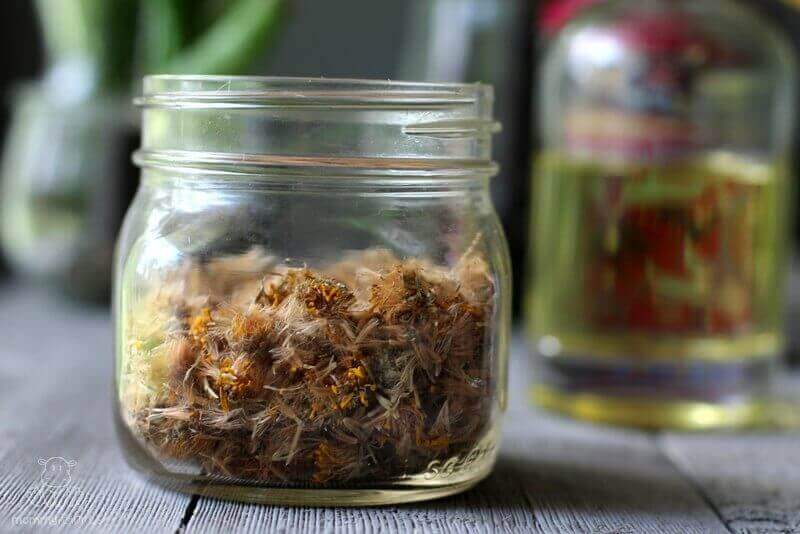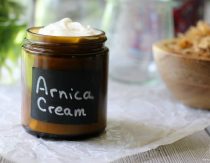
While many herbs have a whole list of uses, like dandelion for detox, digestion and hormone balance, arnica is really good in one area: bumps and bruises! Arnica montana – sometimes called wolf’s bane or leopard’s bane – is a yellow mountain daisy that is believed to help dilate capillaries and stimulate the flow of white blood cells, and has been traditionally used by Swiss mountaineers to prevent muscle soreness. (source)
According to The New York Times, “scientists have found good evidence that it works. One randomized study published in 2007 looked at 204 people with osteoarthritis in their hands and found that an arnica gel preparation worked just as well as daily ibuprofen, and with minimal side effects. Another study of 79 people with arthritis of the knee found that when patients used arnica gel twice daily for three to six weeks, they experienced significant reductions in pain and stiffness and had improved function.”
Arnica has some safety precautions that we haven’t really been concerned with for many of the other herbs in our apothecary – for example, plantain, calendula, yellow dock, and dandelion are all pretty safe both internally and externally. Arnica should only be used externally, should only be used on closed wounds, and should only be used for a short time – up to about six weeks. These criteria make arnica perfect for temporary issues, like
- bumps with pain and swelling
- sprains with pain and swelling
- bruises
- sore or strained muscles
How does arnica work?
Arnica’s therapeutic action comes from its ability to support vasodilation in areas where it is rubbed on the skin. This helps to increase blood flow, which – as mentioned in this article on ice vs. heat therapy for injuries – brings nutrients needed to support healing to the affected area while also carrying away waste from the damaged area.
Herbalist Kami McBride even uses arnica preventatively. If she knows she will be using her muscles more than normal, like for a particularly long hike, she will slather arnica-infused oil all over her body beforehand to reduce muscle soreness the next day. (Source: Handcrafted Healing Herbal Oils Course)
Uses of arnica (And where to buy it)
Arnica flowers are most often used as an infused oil or cream – click here for my homemade arnica oil and arnica cream recipes.
Something to keep in mind when purchasing arnica is that because arnica it’s listed as a species to watch by United Plant Savers (not currently endangered but potentially at risk), it’s important to purchase arnica that is specifically designated as sustainably harvested or cultivated. Sustainably harvest plants are typically gathered from the wild, but some is left behind to ensure that the species remains healthy. Cultivated arnica is grown on farms that have dedicated themselves to making it available for therapeutic use. Purchasing cultivated herbs is a great way to support farmers and the continued production of valuable herbs.
A teeny tiny jar of arnica cream can cost more than $30, but learning to make your arnica oil and/or arnica cream is super cost effective, and very handy for those bumpy bruisy situations. You can buy organic dried arnica blossoms here, and you’ll find my arnica cream recipe here.
Contraindications for arnica
Arnica is an herb to respect. Internally, it can damage many organs, and externally it can cause irritation in some people. It should never be used in the following scenarios:
- Internal use
- Externally on open wounds
- Long-term (more than six weeks on a daily basis)
- Before surgery
- With blood thinners
It is an aster, so be careful if you have a ragweed allergy. Also, if you use it according to recommended guidelines and you experience irritation, discontinue use and switch to another herb.
Is arnica safe for pregnancy and/or nursing?
In addition to the safety precautions above, the Botanical Safety Handbook, 2nd edition, mentions overdoses of arnica infusions and flower tinctures have led to miscarriage. They reported no studies confirming the safety of arnica during lactation. Aviva Romm, MD, RH (AHG), and midwife recommends topical use of arnica for backaches, sore muscles, sore joints, and/or breast pain during pregnancy, even daily, in The Natural Pregnancy Book, 3rd edition. (Keep in mind, of course, that in general it is only used daily for up to six weeks.)
Want more research-backed natural remedies?
No problem, I’ve created a free ebook for you – Kitchen Apothecary: 25+ Natural Remedies Using Ingredients From Your Pantry – as a gift for signing up for my newsletter. You’ll also get updates when I post about safe essential oils for pregnant/breastfeeding mamas, exclusive gifts and coupons (I was able to give away a jar of free coconut oil to anyone who wanted it recently!), plus other goodies.
Sign up using the form below.
About the authors: This article was coauthored by Heather Dessinger and Dr. Lori Valentine Rose (PhD). Dr. Rose, PhD is a college biology, nutrition, herbal, and wellness instructor, Certified Nutrition Professional (CNP), Registered Herbalist with the American Herbalist Guild, and is Board Certified in Holistic Nutrition. She created, developed, and instructs the Hill College Holistic Wellness Pathway, the most thorough, affordable, degreed wellness program in the country. She loves spreading love and light, and helping others feel awesome on the inside and out so they can live their dreams and make this world more awesome!





Our herbalist recommends internal arnica tablets for short periods of time after injuries and before and after surgery. The tablets are readily available in health food stores in Canada. Are they really that dangerous?
We use the external gel too.
Most arnica tablets are homeopathic, which is completely different from consuming the whole flower. Homeopathic tablets are very, very, very (you get the idea here) diluted.
Yes, they are so diluted that they are considered to not even have any actual arnica in them; just the energetics of arnica.
Since there aren’t any studies during lactation I’m hessitant to use it since the flowers shouldn’t be ingested and there is no guarantee that it won’t end up in the milk supply. Is there another option that’s safe to use? I need to find something! My daughter is only 2.5 months so I can’t use essential oils topically the way I want to for a few more months, so I want to find an alternative!
Hi Heather, so appreciate the info re: arnica; I have used arnica montana for over 30 years; one caution: I suggest that people use it for two-three weeks, then take a few (2-3 weeks) breather. Since I play with arnica all the time as I make an herb oil for general pain that contains arnica, I have sometimes experiences an allergic reaction on my hands (itching, redness, etc.). I immediately stop using the arnica, etc. and take about a one-month break from essential oils. Seems to do the trick. Thanks for all your expertise.
I’m wondering why not just use the homeopathic arnica? It’s safer than the herb and stimulates your body to take care of the pain! And it’s super cheap and convenient at most health food stores. I keep it around for bumps bruises and overwork, sore muscles, etc. It’s amazing and actually controlled my sons pain pretty well on the way to the hospital for a bad broken tibia!
I love that homeopathics aren’t contraindicated in pregnancy as long as your using them safely:) If your interested in more check out Joette Calabrese. She gives away a ton of free information on her site!
For the sake of accuracy and clarity I would like to point out the link for arnica you provided is for Mexican Arnica, which is Heterotheca inuloides. It is not the same as Arnica Montana. A. montana is the ingredient used in most commercially available arnica supplements, creams, salves, etc. Heterotheca inuloides is widely used in Mexico for treating various, primarily skin conditions as it does possess some of the same characteristics of Arnica Montana.
Thank you, Nancy! I have updated the link. 🙂
I have those really cool little Magnesium lotion with Arnica, MSM, Lavender and a bunch of other herbs that I found on Amazon that has been really nice to use on my jaw when I am having a 3+ day migraine from TMJ.
I am almost 10 weeks pregnant and desperate. Tylenol has not helped and I don’t want to keep taking it.
I just put this lotion on my jaw and then looked up if topical Arnica is safe in pregnancy. Answers seem quite controversial. But Dr. Aviva MD RH Midwife said it was okay in this article, so I hope I and the little one are okay. <3
Recipes look great! I have been without a kitchen for about a year (renovating a 1911 house – cabinets finally – hopefully – coming tomorrow – although still no counter tops or sink😢) and am looking forward to being able to create some lotions, salves, oils, etc! Thank you for all that you are and all that you do!
Whoa, that’s a serious renovation. I bet it will turn out amazing. 🙂
Keeping my fingers crossed…Cabinets still not delivered – no driver! Hopefully soon and yes, I believe it is truly going to be amazing…my husband is incredible and doing a fabulous job.
Thank you!!